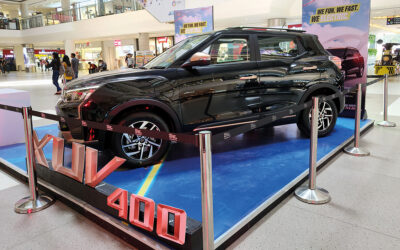Dipak Sen Choudhauri reports on booming sales of electric vehicles in India, which is stimulating the domestic battery market too.

Japan is the world’s third largest producer of cars, behind China and the US, which has 669 cars per 1,000 people. India has 59. And yet, in 2023 India emerged as the country with the third largest sales of new cars – at 5.07 million, it registered a 7% growth over the previous year.
India has just managed to forge ahead of Japan, China and US in terms of growth rate. It is in this context, the 59 cars per 1,000 population of India looks such an enormous opportunity that, with a population of 1.5 billion, the country’s aspiration to become the numero uno of global auto manufacture is distinctly possible.
The government of India has projected 2028 as the date when India will emerge as the third largest economy in the world with a projected GDP more than $5 trillion. And by 2030, the country will be hitting 500GW of non-fossil-fuel-based energy generation and achieving 30% of new vehicles being pure-electric.
Currently, India spends $150–200 billion of precious foreign exchange every year on crude oil as well as finished petroleum product imports. A significant switchover to electric mobility will bring an enormous relief to the nation’s economy as well as do wonders for India’s horribly polluted cities and towns.
The Indian economy macro figures seem to be moving on well. If the stock exchange sentiments are to be relied upon, the market is on a raging bull run. The economy, environment, the national border sentiments are all at a high. However, with the national parliamentary elections due this year there could be dressing up of some of the figures to some extent. Nevertheless, the industry sentiments do look positive.
EV sales nearly doubled
One of the key figures going around is the data that India’s EV sales nearly doubled in 2023. Further, the projections are that in 2024 we may expect a further 66% growth in EV sales with the overall share of EVs going up to 4% of all new passenger vehicle sales. This is very promising indeed and is being driven partly by government direct and indirect subsidies, as well as a market response to a whole bunch of new EVs hitting the ground, from Indian and international manufacturers.

Leading the pack is the Tata group who introduced the new Tata-Punch EV sedan, a comfortable, spacious four-seater sedan at an attractive cost of ₹1.2 million ($14,000) for the base version with a range of 315km powered by a 25kWh LFP battery. It has an option for a 421km-range, 35kWh battery too. Tata of course continues to promote their earlier models Nexon and Tiago, both of which have good reviews as comfortable, zippy vehicles.
The other Indian manufacturer, Mahindra, finally got its act right by bringing out an electric SUV after experimenting with EV sedans. One has to understand that passenger EVs, as of now, still continue to be a ‘fancy purchase’ out of reach of average budget buyers.
Aspiration for an SUV
An interesting aspect of the upwardly mobile young Indian middle class is the aspiration to buy an SUV rather than a sedan. This somewhat goes with the ‘macho’ image of the new generation which has just arrived, driving a big car.

Also, at another end the Indian family travels big – parents, kids, attendants all together for a weekend drive and hence a bigger vehicle helps. All in all, it has made the SUV the fastest growing segment of passenger car sales and the Mahindras cashed in on this sentiment to launch their XUV400 electric SUV model. The vehicle is getting noticed amongst the younger buyers with not so unlimited budget and is now doing good business.
Amongst the overseas manufacturers, leading the pack is now BYD closely followed by MG motors. BYD had started with the e6 MPV and Atto 3 SUV and has now launched its ‘Seal’ model which is attracting great attention. At any time, if you are on any Indian city road, you cannot miss the fact that an electric car is visible almost every minute. It is growing and growing fast.
Getting the ecosystem in place
The overall ecosystem to support the EV sustenance is also getting into place with almost every shopping mall, airport and railway station having added facilities for EV charging. More importantly, many filling stations are adding charging stations to their repertoire, hopefully after taking sufficient safety precautions.
Lithium batteries on charge and tanks full of petroleum products do not go together very well. Hopefully this is realised. In fact, the Tata group has recently signed a memorandum with the state-owned oil marketing company, Hindustan Petroleum (HPCL), for the setting up of 5,000 charging stations across the whole country. HPCL already has close to 3,000 charging stations in operation in various parts of the country.
Perhaps, one of the most significant news items that has come around on the subject is the fact for the first time one of India’s significant OEMs has signed an agreement to source its lithium battery requirements – from cell to module to pack – from an Indian manufacturer only.
Hyundai India and Exide Energy Solutions, a subsidiary of Exide Industries, announced the signing of the deal confirming the localisation plan of the auto OE, so far as their lithium battery requirements are concerned, for vehicles produced in its Indian plant.
Exide Energy Solutions is in advanced stages of commencing LFP & NMC cell manufacture in the new giga-plant being set up near Bangalore, with close technical support of Svolt from China. The unit is set to make its first output by the end of the current year.
Twist in the tale
Everything looks good, all plans made, executions in progress, results starting to trickle in. For once, project timelines too seem to be well under control. We leave this story with a slight twist in the tale which goes as follows.
Something is happening amongst first generation Indian vehicle buyers. In the past, say in 2018, the share of entry level small cars in overall vehicle sales stood at 47.4%. In 2023 this came down to 34.4%. In 2024 the figure is not looking any better, at 27.7%, On the other hand, the sales of SUVs as a percentage of overall vehicle sales have gone up significantly over the same period.
The last few years, both pre and post covid, has seen a sharp rise in vehicle costs arising out of requirements to meet the increasingly stringent emission norms, the semiconductor crisis and generally higher commodity prices. The increase has been far sharper for small cars, which perhaps needed the highest upgrades to align with new regulations.
This is so much so that typically, during these last five years, the increase of small hatchback passenger vehicles have been to the tune of 65% with respect to their base price whereas for sedans and SUVs this has been only around 25%.
The backdrop to the sharply escalating prices is that the common worker’s income has grown at a much, much slower rate and has been left behind by far. The aspirations of buying a four-wheeler for the family is now abandoned.
They settle for two wheelers or, at best, a used car. The market for second hand cars seems to have developed a lot in the last couple of the years. The auto OEMs too have shifted their focus from small cars to SUVs where the profits are fatter. Customers are eager to accept newer features, as many as you can add.
There is a bit of optimism going around this. Some feel the Covid experience, together with market prices going up sharply, has left the consumers shaken. Slowly, the confidence is likely to come back amongst buyers and they will eventually come back to the market and buy small cars once again; and this will happen from this year.
If that happens, then it’s good. Or, under the circumstances, the chances of popularising EVs amongst the Indian masses in general will get buried permanently. EVs will remain the fancy possession of the rich and the upper middle class who would go back to their fancy sedans once the novelty of owning an EV is over. That will be bad, and one hopes it does not happen. The bottom line is simple. The acquisition cost of EVs is still very high. Only when this comes down to the level where the Indian small car owner can hope to afford one, will the EV emerge as part of Indian life.












